Resetting the Avionics Repair Norm
When faced with the need to repair an Avionics fault the default assumption often made is that an Avionics 'box' - a Line Replaceable Unit (LRU) - will be the source of the problem. This ‘LRU Replacement Norm’ has been unchallenged in aviation maintenance organisations for decades.
Avionics repair success rates reveals, unsurprisingly, that not all repairs are successful. Unsuccessful repairs cause repeat arisings and repair rework, which incur additional and avoidable time, spares and cost to successfully rectify the problem. Meanwhile the LRU that was incorrectly removed after the original fault arising is sent for a repair it doesn’t actually need, also consuming additional time, spares and cost.
At best this Norm leads to costly repeat arisings that degrade aircraft operational reliability or despatch rates; at worst it impacts on safety and airworthiness.
 A one-size-fits-all solution is not feasible because Avionics faults and their root causes vary significantly, and these fault root causes are heavily influenced by the platform life-cycle, similar to the ‘Bath-tub’ curve model:
A one-size-fits-all solution is not feasible because Avionics faults and their root causes vary significantly, and these fault root causes are heavily influenced by the platform life-cycle, similar to the ‘Bath-tub’ curve model:
- Repair success levels versus different cause types will evolve as experience is gained on type.
- Conversely the range of fault types will evolve over time with early-stage integration faults reducing in regularity whilst the number of ageing-driven mechanisms such as wiring insulation problems begins to steadily increase.
The LRU Replacement Norm does not take such factors into consideration. An alternative, evidence-driven technological approach is urgently needed to reset the Norm in order to significantly increase Avionics repair success rates.
